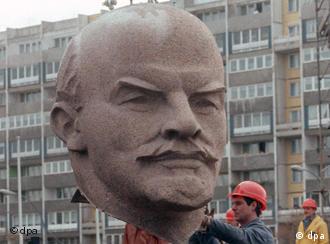It appears that Lenin's head has been lost in Berlin or at least that is what the German authorities want prospective art curators to believe according to a report last week in the British Guardian (and other sources). Here is most of the Guardian's report from August 21st:
More than two decades after it was torn down, Berlin authorities have admitted the giant monument may be lost in storage.
Curators of an exhibition about the German capital's monuments had proposed to including the Russian revolutionary's 1.7-metre (5.6ft) head in their show, scheduled for spring 2015. Between 1970 and 1991, the statue had stood on Lenin Square in Berlin's Friedrichshain district. After its removal, it was cut into 129 pieces and buried in a pit in Köpenick.
But last week the Berlin senate rejected the curators' proposal to excavate Lenin's head, arguing that they didn't know its precise location and would therefore have to dig up the entire pit, long overgrown with shrubs and trees: too costly an undertaking for the city's cash-strapped authorities.
Politicians and historians have criticised the decision. Members of the leftwing Die Linke went as far as suggesting that the mayor, Klaus Wowereit, was ideologically motivated: "They are even still scared of that stupid old head," the MP Wolfgang Brauer told the Taz newspaper.
A US film-maker has offered his services to help locate the misplaced head: in 1994, Rick Minnich had dug his way to it as part of his documentary The Book of Lenins. "Everything in Germany is documented," he told Berliner Zeitung, "so there are bound to be documents in this case too."
The exhibition curator, Andrea Theissen, also claims to be in possession of a map showing the head's precise location. "The Lenin statue is an important document to show how a united Germany has dealt with the history of the GDR," she told the Guardian.
So far, the senate has not shown any interest in Theissen's map, but she said she had not given up hope that the Russian revolutionary could still become the most famous exhibit in her show, which will display more than 100 original Berlin monuments from the 18th century to the fall of the Wall.
If the senate changes its mind, it will have to do so within the next month. The pit where the statue has been dug up is home to a protected species of lizard that goes into hibernation in October, preventing any excavation work from being carried out in time for the exhibition.
As a backup, the curators might want to consider locating a prop from Good Bye Lenin: the statue shown in the film is a bronze copy, not the original made of granite. 

No comments:
Post a Comment